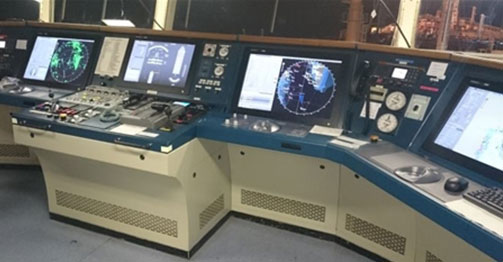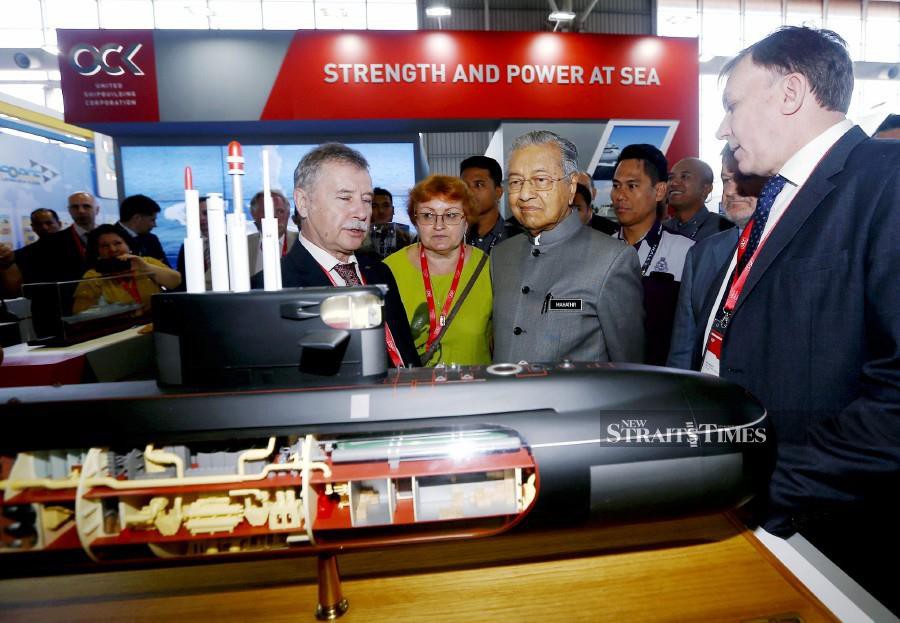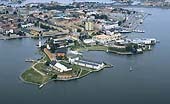by | Nazery Khalid
Author’s Profile
Nazery Khalid is Honorary Secretary, Association of Marine Industries of Malaysia (AMIM) an association featuring Malaysian shipyards and various enterprises and institutions involved in various activities in the marine industries. Nazery has carried out several consultancy works for various government agencies and private sectors in the areas of ports, shipping, logistics, offshore oil and gas and supply chain, and conducted training on those subjects. He is widely regarded as a subject matter expert in the field of maritime economics and his views are sought after by industry players and the media. The opinion expressed are his own.
We are now living in a digital era and operating within an increasingly digital economy. The world’s fastest growing and largest corporations are no longer the ‘brick and mortars’ type of companies producing and processing raw materials, commodities and manufacturing goods. But the world’s biggest and most valuable companies are now tech-based manufacturers and Internet-related service providers such as Apple, Alibaba, Amazon, Dell, Facebook, HP, Lenovo, Microsoft and Tencent. These companies have exceeded the achievements of the traditional bricks and mortar companies—in terms of value—amid the global shift towards e-commerce, online communication and cashless B2B and B2C transactions.
Online shopping, banking and learning, telemedicine, ride sharing, cryptocurrencies as well as blockchains, are all the rage now impacting our lives profoundly while we brace for more new developments and disruptions brought about by the 4th Industrial Revolution (4IR). 4IR is a definite game changer in revolutionising the way business is performed in the digital age. It is a fusion of the digital and physical worlds, thanks to the advent of telecommunications, information technology and the Internet. The convergence of technologies has resulted in faster, more efficient and cheaper transmission, exchange and processing of information and data. This in turn translates into greater competency and productivity, better decision making, increased trade and improved bottom line for companies.
These technologies have also challenged the status quo, driving businesses to reconfigure their organisational set-up, corporate objectives and strategies. To speed up Malaysia’s move towards becoming a truly globally competitive economy and transform its manufacturing sector into a smart and digitalised one, the Government has taken several initiatives at the national, state and regional levels. These entail working with industries, businesses and the academia to develop tailor-made solutions of respective industries to the meet specific needs of I4.0, which cover areas such as infrastructure development, financing, training and education, human capital development, regulatory framework and many others.
The government has also introduced a holistic National Framework for Industry 4.0 Framework with a targeted agenda to transform Malaysia’s manufacturing sector into a digitalised one. This underscores the acknowledgment by the Government of the sector’s importance, as underlined by its 23 percent contribution to the nation’s GDP.
Through the framework, the Government intends to position Malaysia as a smart manufacturing destination globally. The framework created to attract FDI into the manufacturing sector and move up the value chain in the industry as well as for the world’s top manufacturing multinational companies to gain differentiation—in line with the goal of transforming Malaysia’s economy into a fully developed nation through high income, value adding economic activities.
Marine Industry in the Digital World
Propelling the 4IR revolution forward is a range of advanced technologies that have made the world a seemingly smaller place, enabling people and businesses to connect instantly and share huge amounts of data in realtime basis— among the technologies are additive manufacturing (or 3D printing), artificial intelligence (AI), autonomous robots, augmented reality, big data analytics, cloud computing, cybersecurity, Internet of Things, machine learning, nanotechnology, quantum computing, remotely controlled vehicle, social media and virtual reality. These technologies have the potential to alter the way people and businesses reach out to one another, and will continue to reshape the landscape of businesses, industries and trade. In the marine industry, subsectors within the industry such as shipping, port operations and shipbuilding have got into the groove of going digital and surf with the wave of I4.0. Some shipping companies are already using real-time information to send and receive data on cargos transported by their vessels. Autonomous, crewless ships are being tested, and ships with e-navigation features such as electronic charts and technologically-driven environmentally friendly and energy efficient characteristics are more the norm than exception these days.
The world’s top shipyards now use sophisticated computer aided design software to design ships and share draft designs through cloud with shipowners, consultants, marine equipment and systems manufacturers and classification societies. Ports use IT extensively to plan container loading and offloading onboard ships and to track containers in port yards. While remotely controlled, autonomous vehicles and robotics are increasingly used in repair and maintenance work at yards to check the integrity of vessels and off shore structures. While there is a clear trend of the marine industry warming up to I4.0, there are still acres of room for extensive use of technologies and online platforms for the industry to become safer, more efficient, environmental friendly and cost efficient. These include areas such as cargo tracking, maritime supply chain security, environmental protection, navigating safety, planning, operations, administration and monitoring.
A more tech-savvy and increasingly digitalised marine industry would trigger tremendous multiplier effects which will benefit not only the shipping companies but also the environment and other stakeholders along the marine industry supply chain, such as cargo owners, businesses, industries, logistics companies, marine ancillary services providers, regulators and eventually consumers and economies as well.
Although efforts have been made by players in the marine industry to adapt to I4.0, there is still slight hesitation by some to be up to speed with the hi-tech world that is changing the industry’s landscape. There are several impediments nation’s economy and has linkages to many industries and sectors including transportation, steel, plastics, engines and equipment, commodities and a range of services such as financing, classification, naval design, legal, tax, research and consultancy. The local SBSR industry is heavily influenced by the advent of technologies. It is exposed to developments in the shipping and SBSR industries worldwide, albeit being behind in terms of sophistication and technological advancement compared to the world’s major shipbuilding nations. The leading shipyards in the country are able to build fairly sophisticated middle size vessels, offshore support vessels (OSV) for clients in the United States, Europe, Australia and New Zealand as well as service largesized vessels. The top shipyards have cutting edge equipments such as plasma cutters which cut through electrically conductive materials using an accelerated jet of hot plasma, and CNC (Computer Numerical Control) machines using computers executing preprogrammed sequences of machine control commands. Some also use huge cranes and employ processes that use sophisticated computers and even artificial intelligence. With IR 4.0 seemingly unstoppable now, the SBSR industry uses various types of technologies and contributing to this such as lack of understanding about I4.0 and the opportunities it brings, resistance towards technologies, conservative business strategies, lack of regulatory/policy push, absence of financing to invest in assets, solutions and human capital, and even reluctance to spend.
As the wave of digitalisation sweeps forcefully and leaving an indelible mark on the world, it is futile to maintain the conservative ways of doing business and expect to remain competitive within the new digital order. With all new things, there is always resistance to change. As the maritime industry suffer from the downturn, scaling back and refraining from investing in assets not central to their businesses, questions are being asked on whether adopting new technologies in the I4.0 context can create real economic value and generate competitive advantage to their business. In this regard, efforts needed from stakeholders includes educating lead agencies and industry associations about I4.0 and highlighting the need to adopt to it as well as the issues, challenges, threats and opportunities. The forces unleashed by I4.0 are too strong to resist and marine industry players should swim with its tide to be sustainable and remain competitive.
SBSR Sector : At the Forefront of I4.0
To this end, the shipbuilding / ship repair sector or SBSR is well positioned to catch the wave of this revolution. The industry has been accorded strategic status by the government, as outlined in Industrial Master Plans, given its importance to the nation’s trade, economy and defence. It creates tremendous multiplier effects to the nation’s economy and has linkages to many industries and sectors including transportation, steel, plastics, engines and equipment, commodities and a range of services such as financing, classification, naval design, legal, tax, research and consultancy.
The local SBSR industry is heavily influenced by the advent of technologies. It is exposed to developments in the shipping and SBSR industries worldwide, albeit being behind in terms of sophistication and technological advancement compared to the world’s major shipbuilding nations. The leading shipyards in the country are able to build fairly sophisticated middle size vessels, offshore support vessels (OSV) for clients in the United States, Europe, Australia and New Zealand as well as service large sized vessels. The top shipyards have cutting edge equipments such as plasma cutters which cut through electrically conductive materials using an accelerated jet of hot plasma, and CNC (Computer Numerical Control) machines using computers executing preprogrammed sequences of machine control commands. Some also use huge cranes and employ processes that use sophisticated computers and even artificial intelligence.
With IR 4.0 seemingly unstoppable now, the SBSR industry uses various types of technologies and equipment, and features many activities, driven by ICT and data. Already we are seeing IR 4.0 making a mark in leading shipyards in South Korea, Japan, Norway and the Netherlands in areas such as big data analytics, Internet of things, cloud computing, artificial intelligence, robotics, additive manufacturing or 3D printing, and systems integration. These developments are creating exciting new opportunities for shipyards and shipowners, along with the inevitable challenges in areas such as changes to the SBSR workforce, processes and operations, and the end products and services.
I4.0 : The Future is Already Here
To prepare marine industry players to adjust to the sweeping changes of I4.0, building awareness on the topic is essential. They need to understand what drives the digital revolution, how different technologies inter-operate with one another, what opportunities a techdriven industry can generate, what economic values I4.0 can unlock and how companies can improve their bottom-line amidst this revolution.
In particular, shipping companies need to understand that value can be created by using IT to automate processes, enhance efficiency and productivity, and integrate certain aspects of the business such as operations and management. Big data analytics can be used to make more informed and precise decisions, for example in route planning, ship deployment, navigation safety, commissioning of newbuildings (new vessels) and laying-up or scrapping of vessels. This would lead to a smart shipping strategy in which shipowners can deliver cargo more efficiently through automation of ship operations and efficient management of personnel and shipping fleet.
Regulatory requirements are on the rise and generating considerable demand for players in the industry to invest in assets and personnel, and change their operations and strategies to ensure compliance. While this poses a challenge, there are also opportunities presented by the use of technologies and innovative solutions—such as e-commerce, satellite communications and online platforms—to meet regulatory requirements. By adopting the technologies, shipowners stand to enhance productivity, and amass quality assets which are more environment friendly, have better performance and would be less costly to maintain.
Certain activities in the marine industry such as shipping and port operations are cross-border in nature as they involve long supply chains across borders and jurisdictions. As international players in these fields enhance their use of new technologies and increasingly adopt e-commerce in their operations, their Malaysian counterparts must also step up to the plate in tandem so as not to lose out on the opportunities presented by the digital economy.
Those lagging behind in joining I4.0 do so at their peril as the industry shifts to a higher gear to fit into the way of doing things.
PLAN OF ACTION
The following is a plan of action to prepare industry players to adopt to I4.0 thus enabling them to face the challenges and reap the opportunities it brings:
1 Adopting a comprehensive, inclusive business strategies that adopts I4.0 technologies suitable for the business. Attaining a 4.0 vision, strategies and roadmap is essential for businesses in today’s digital marketplace in order to drive and attain tangible return on investment their enterprises. This can pave the way towards optimization of invested capital, and the unlocking, creation, preservation and enhancement of the companies asset.
2 Providing skilled, well trained human capital especially in the fields of STEM (science, technology, engineering and mathematics). In this regard, training and education establishments, including specialized maritime ones, should introduce more STEM-based courses relevant to industry needs to prepare a tech-savvy workforce which can hit the ground running and flourish in a digital, hi-tech environment.
3 Ensuring the availability of necessary infrastructures such as high-speed Internet connectivity to facilitate the delivery, storage and sharing of vast amount of data in a fast, cost effective and secure manner. The roles of governments and telecommunications companies are crucial in facilitating this.
4 Reducing the cost of doing business in the digital economy. In this regard, the government needs to reduce red tapes, develop business friendly rules and improve service delivery, performance and service standards to facilitate more activities in the I4.0 context.
5 Putting in place a well defined, user-friendly and business-friendly digital economy framework for the marine industry to thrive and prosper. In this regard, strategies for the marine industry such as the existing Malaysia Shipbuilding / Ship Repair Master Plan 2020 and the planned Malaysia Shipping Master Plan must be reviewed / developed to include I4.0 as one of their pillars.
6 Introducing special financing incentive schemes for players in the marine industry, especially SMEs with limited access to financing, to enable them to procure assets, upgrade back offices and technologies, build manpower, establish connectivity and undertake R&D to do business in the digital economy. In addition, special incentives can be considered to lay out capex to acquire technologies to reduce emissions/noise (for example from ships), use clean fuels / adopt low energy strategy, enhance business performance, expand service offerings and explore new markets.
7 Creating awareness among industry players of the virtues of the digital economy and the opportunities and economic value waiting to be unlocked and reaped within the I4.0 landscape. In this regard, government agencies such as the Maritime Division of the Ministry of Transport and Malaysia Digital Economy Corporation (MDEC), and industry lead bodies such as the Association of Marine Industries of Malaysia (AMIM) and Malaysia Shipowners Association (MASA) can play a leading role in raising awareness among industry players and stakeholders. The Ministry of International Trade and Industries (MITI), which is preparing the National Framework for Industry 4.0, can act as the lead agency to coordinate and support efforts by respective industries to adapt to I4.0.
The Digital Future is Here
As the world shifts to a higher gear in adopting I4.0 and embracing the digital economy, players in the marine industry must keep abreast with technological trends to stay relevant and thrive in the digital era.
To do so, a holistic approach is needed to bring stakeholders up to speed with the new world order shaped by I4.0. Policymakers, government agencies, users of marine industry services and products, educational and training institutions and other stakeholders must adjust to the demands of intensive use of ICT and the Internet in today’s digitalised marketplace. Industry practitioners must work on recalibrating their business strategies, restructuring their organisations, sourcing financing, developing human capital and choosing the right technologies to adopt to the new normal that technologies bring.
The so-called digital future is already here and it is already making a mark on the marine industry. As such, it is important that industry players swim with the flow. The speed with which the world is changing means industry players can no longer move at a leisurely pace with technology uptake and changes and developments triggered by I4.0.






